Peter.
Titanium
- Joined
- Mar 28, 2007
- Location
- England UK
I'm rebuilding a small manual grinder - an Eagle Mk3 W. Got nearly all of the scraping work done and I'm looking for advice on a couple of bits.
Despite sitting under a tarp for 10 years the spindle turns nice and smooth by hand (I had to cut the rock-hard belt off first) so I pulled the rear cover and found the grease was still greasy - no dried out hard lumps or dirt but the grease is very yellow. There's a grease cup that just dumps grease into the cavity behind the bearing so it's stuffed full.

I cleaned out all the yellow grease and the stuff that is in the bearing is more liquid and brown colour., more like regular grease colour.

What I'm wondering is if the yellow grease is brown grease that has started drying out, or if the brown grease is yellow grease that's changed colour from rust or water or something? What do we think? Tag specifies castrol Spheerol AP1, which you can't get though you can get AP2 so I'll use that.
I levered up on the rear of the spindle with a small wooden stick in the gap and got .0003" radial play with the machine stone cold. Does that seem reasonable?
With the wheel off I can get 5 thou end float in the bearings. If I fit a spacer in place of the wheel and pull the nut up the end-float disappears. So it seems to me that the rear bearing is floating and the front bearing pre-load is actually set by the wheel nut. Does that seem reasonable? Seems a rather odd arrangement to me.
I'm rather loathe to pull the spindle and disturb the bearings without good cause. What would you do? Grease them with fresh grease and see how it grinds or strip it out and clean the lot up?
Last question - the tag specifies Castrol Magna ZA for the slideways. I can't find any data on that. I have some regular way oil but it's quite heavy and I'm concerned that it will be slow to trickle down the galleys to the ways. The grinder has an odd arrangement that seems like you travel the table to each end and fill an open trough from an oil can. I don't want to ruin all my scraping work so can anyone help with the spec for that oil. Options for modern Castrol seem to be ISO32, 68, 150, 220. What weight oil would normally be used for a manual grinder?
Cheers for any help.
Pete.
Despite sitting under a tarp for 10 years the spindle turns nice and smooth by hand (I had to cut the rock-hard belt off first) so I pulled the rear cover and found the grease was still greasy - no dried out hard lumps or dirt but the grease is very yellow. There's a grease cup that just dumps grease into the cavity behind the bearing so it's stuffed full.

I cleaned out all the yellow grease and the stuff that is in the bearing is more liquid and brown colour., more like regular grease colour.

What I'm wondering is if the yellow grease is brown grease that has started drying out, or if the brown grease is yellow grease that's changed colour from rust or water or something? What do we think? Tag specifies castrol Spheerol AP1, which you can't get though you can get AP2 so I'll use that.
I levered up on the rear of the spindle with a small wooden stick in the gap and got .0003" radial play with the machine stone cold. Does that seem reasonable?
With the wheel off I can get 5 thou end float in the bearings. If I fit a spacer in place of the wheel and pull the nut up the end-float disappears. So it seems to me that the rear bearing is floating and the front bearing pre-load is actually set by the wheel nut. Does that seem reasonable? Seems a rather odd arrangement to me.
I'm rather loathe to pull the spindle and disturb the bearings without good cause. What would you do? Grease them with fresh grease and see how it grinds or strip it out and clean the lot up?
Last question - the tag specifies Castrol Magna ZA for the slideways. I can't find any data on that. I have some regular way oil but it's quite heavy and I'm concerned that it will be slow to trickle down the galleys to the ways. The grinder has an odd arrangement that seems like you travel the table to each end and fill an open trough from an oil can. I don't want to ruin all my scraping work so can anyone help with the spec for that oil. Options for modern Castrol seem to be ISO32, 68, 150, 220. What weight oil would normally be used for a manual grinder?
Cheers for any help.
Pete.







